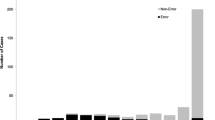Abstract
Despite an increasing focus on patient safety in ambulatory care, progress in understanding and reducing diagnostic errors in this setting lag behind many other safety concerns such as medication errors. To explore the extent and nature of diagnostic errors in ambulatory care, we identified five dimensions of ambulatory care from which errors may arise: (1) the provider–patient encounter, (2) performance and interpretation of diagnostic tests, (3) follow-up of patients and diagnostic test results, (4) subspecialty consultation, and (5) patients seeking care and adhering to their instruction/appointments, i.e. patient behaviors. We presented these risk domains to conference participants to elicit their views about sources of and solutions to diagnostic errors in ambulatory care. In this paper, we present a summary of discussion in each of these risk domains. Many novel themes and hypotheses for future research and interventions emerged.
Similar content being viewed by others
References
Aiello Bowles, E. J., Tuzzio, L., Wiese, C. J., et al. (2008). Understanding high-quality cancer care: A summary of expert perspectives. Cancer, 112, 934–942.
Gandhi, T. K., Kachalia, A., Thomas, E. J., et al. (2006). Missed and delayed diagnoses in the ambulatory setting: A study of closed malpractice claims. Annals of Internal Medicine, 145, 488–496.
Graber, M. L., Franklin, N., & Gordon, R. (2005). Diagnostic error in internal medicine. Archives of Internal Medicine, 165, 1493–1499.
Langenbach, M. R., Schmidt, J., Neumann, J., & Zirngibl, H. (2003). Delay in treatment of colorectal cancer: Multifactorial problem. World Journal of Surgery, 27, 304–308.
Phillips, R. L., Jr., Bartholomew, L. A., Dovey, S. M., Fryer, G. E., Jr., Miyoshi, T. J., & Green, L. A. (2004). Learning from malpractice claims about negligent, adverse events in primary care in the United States. Quality & Safety in Health Care, 13, 121–126.
Rayson, D., Chiasson, D., & Dewar, R. (2004). Elapsed time from breast cancer detection to first adjuvant therapy in a Canadian province, 1999–2000. CMAJ, 170, 957–961.
Redelmeier, D. A. (2005). Improving patient care. The cognitive psychology of missed diagnoses. Annals of Internal Medicine, 142, 115–120.
Rosenthal, M. M., & Sutcliffe, K. M. (2002). Medical error: What do we know, What do we do? Hoboken, NJ: Wiley.
Schiff, G. D. (1994). Commentary: Diagnosis tracking and health reform. American Journal of Medical Quality, 9, 149–152.
Singh, H., Arora, H. S., Vij, M. S., Rao, R., Khan, M., & Petersen, L. A. (2007a). Communication outcomes of critical imaging results in a computerized notification system. Journal of the American Medical Informatics Association, 14, 459–466.
Singh, H., Naik, A., Rao, R., & Petersen, L. (2008). Reducing diagnostic errors through effective communication: Harnessing the power of information technology. Journal of General Internal Medicine, 23, 489–494.
Singh, H., Petersen, L. A., & Thomas, E. J. (2006). Understanding diagnostic errors in medicine: A lesson from aviation. Quality & Safety in Health Care, 15, 159–164.
Singh, H., Sethi, S., Raber, M., & Petersen, L. A. (2007b). Errors in cancer diagnosis: Current understanding and future directions. Journal of Clinical Oncology, 25, 5009–5018.
Singh, H., Thomas, E. J., Khan, M., & Petersen, L. A. (2007c). Identifying diagnostic errors in primary care using an electronic screening algorithm. Archives of Internal Medicine, 167, 302–308.
Wahls, T. L., & Cram, P. M. (2007). The frequency of missed test results and associated treatment delays in a highly computerized health system. BMC Family Practice, 8, 32.
Weingart, S. N., Wilson, R. M., Gibberd, R. W., & Harrison, B. (2000). Epidemiology of medical error. BMJ, 320, 774–777.
Woods, D. M., Thomas, E. J., Holl, J. L., Weiss, K. B., & Brennan, T. A. (2007). Ambulatory care adverse events and preventable adverse events leading to a hospital admission. Quality and Safety in Healthcare, 16(2), 127–131.
Acknowledgments
Dr. Singh is supported in part by the Houston VA HSR&D Center of Excellence (HFP90-020).
Author information
Authors and Affiliations
Corresponding author
Additional information
The views expressed in this article are those of the authors and do not necessarily represent the views of the Department of Veterans Affairs.
Rights and permissions
About this article
Cite this article
Singh, H., Weingart, S.N. Diagnostic errors in ambulatory care: dimensions and preventive strategies. Adv in Health Sci Educ 14 (Suppl 1), 57–61 (2009). https://doi.org/10.1007/s10459-009-9177-z
Received:
Accepted:
Published:
Issue Date:
DOI: https://doi.org/10.1007/s10459-009-9177-z




